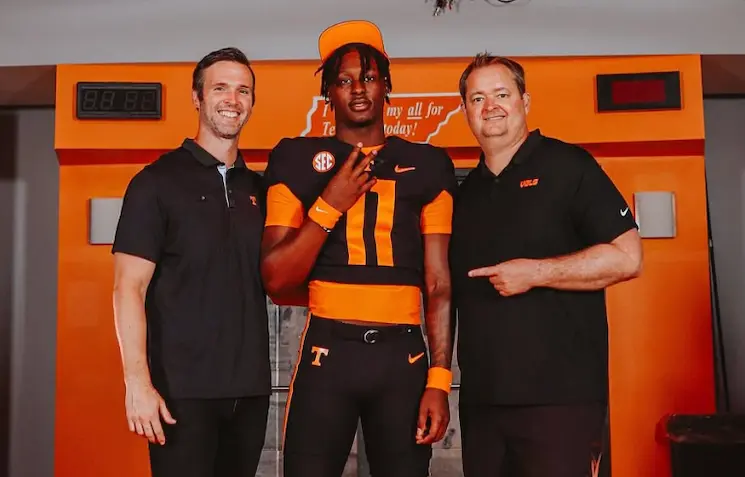
One of the biggest disappointments for the Vols to start this season has been their offensive line. With a lot of four and five-star talent in the unit, a lot of Vol fans were hoping that Tennessee’s offensive line could transform into a strength or at least be above average under a new coaching staff.
What’s happened instead has been the complete opposite.
The Vols’ offensive line has struggled to play well consistently, and the depth along the line doesn’t help matters. Tennessee simply doesn’t have the bodies or experience to replace some of the struggling linemen, and several players are having to play out of position because other positions don’t have the right fit behind them on the depth chart.
How did it get this way? How did Tennessee’s offensive line, a unit that’s been a big focus in recruiting over the years, get in such shape?
Injuries, attrition, and lack of development have all contributed to the Vols’ woes on the offensive line this year. I’ve taken a look at the roster, the past recruiting classes, and compared them to some of the best lines in the SEC. And it’s clear why Tennessee is in the spot they’re in.
For one, Tennessee has no scholarship senior offensive linemen on the roster. They do have a couple redshirt juniors, however, but the Vols have zero senior linemen on the roster right now. And even the fourth-year players they have right now have been disappointing for their own reasons.
The trouble really begins with the 2015 recruiting class. That class in general has been a bane for Tennessee because of the large amount of attrition it experienced, and that’s true for the offensive line in that class as well. Only two of the five offensive linemen UT’s previous coaching staff brought in from that class are still on the roster, and one of them — Chance Hall — has had injuries plague what looked to be a promising career. The other is Drew Richmond, and his issues have been well-documented this season.
Tennessee is having to rely heavily on first and second-year players because of the attrition and injuries to the 2015 class. And that’s also where the lack of development comes in.
The Vols have one fourth-year player (Richmond), one third-year player (Ryan Johnson), a second-year player (Trey Smith), and two first-year players (Jerome Carvin, Jahmir Johnson) as their starters on the offensive line. Those five players have a combined 48 starts in their careers counting this season. Those five linemen average a height of just over 6-foot-5, and they average 305.2 pounds per lineman along the starting five.
Tennessee’s linemen have length, but they lack girth and experience. And that’s where they differ from two of their top rivals and two of the best offensive lines in the SEC: Alabama and Georgia.
Alabama’s starting five offensive linemen this season have a redshirt senior, a senior, and a junior to go along with two sophomores. They average a height of just under 6-foot-5, and they average 309.3 pounds. Those five linemen also have a combined 110 starts in their careers.
Georgia isn’t as experienced as Alabama, but they have even more size than the Tide’s line right now. Their five starters for most of the season (Andrew Thomas has started three of four games but missed a game, and Cade Mays started for him) average just under 6-foot-5 and 327.6 pounds. They have a redshirt senior at center — just like Alabama — and have two redshirt sophomores along with a sophomore and a redshirt freshman. Their line has a combined 74 career starts.
Both Alabama and Georgia’s offensive lines are more stout and more experienced than Tennessee’s. And, for the most part, they haven’t dealt with as many injuries as Tennessee’s either. Neither Alabama nor Georgia’s lines are relying on any first-year players to be regular starters like the Vols either.
The Vols have already had injury issues on the offensive line this season as well. Alabama grad transfer Brandon Kennedy — a redshirt junior who measures in at 6-foot-3, 301 pounds but was also a first-time starter — is out for the season after sustaining an injury the week of practice after Tennessee’s first game. That’s forced true freshman Jerome Carvin into a starting role and moved Ryan Johnson, a third-year player but inexperienced starter, to move to center. Johnson only has eight career starts counting this season.
Both Georgia’s and Alabama’s most experienced linemen this year are their centers. Alabama’s center, Ross Pierschbacher, is a redshirt senior with 46 career starts including this year. Georgia’s center, Lamont Gaillard, is also a redshirt senior and has 32 career starts.
Tennessee has more or less played musical chairs on the offensive line over the last season and a half because of injuries, poor play, and attrition. And when you compare them to the teams UT’s coaches are striving to be like, it’s apparent why Tennessee has struggled so mightily on the offensive line this season.
Here’s a breakdown of Tennessee’s offensive line recruiting classes dating back to the 2015 class:
2015 class
Drew Richmond, RS Jr. – 17 career starts
Jack Jones – career cut short due to injury
Venzell Boulware – transferred
Chance Hall RS Jr. – 13 career starts (missed full season and part of another due to injury)
Zach Stewart – never played
2016 class
Ryan Johnson, RS So. – 8 career starts
Marcus Tatum RS So. – 3 career starts
Nathan Niehaus RS So. – no starts
2017 class
Trey Smith So. – 16 career starts
Eric Crosby RS Fr. – no appearances (originally recruited as defensive lineman)
Riley Locklear So. – 4 career starts
K’Rojhn Calbert RS Fr. – one appearance
2018 class
Jerome Carvin Fr. – starter this season (3)
Jahmir Johnson RS So. – starter this season (4)
Tanner Antonutti Fr. – no appearances
Ollie Lane Fr. – no appearances



